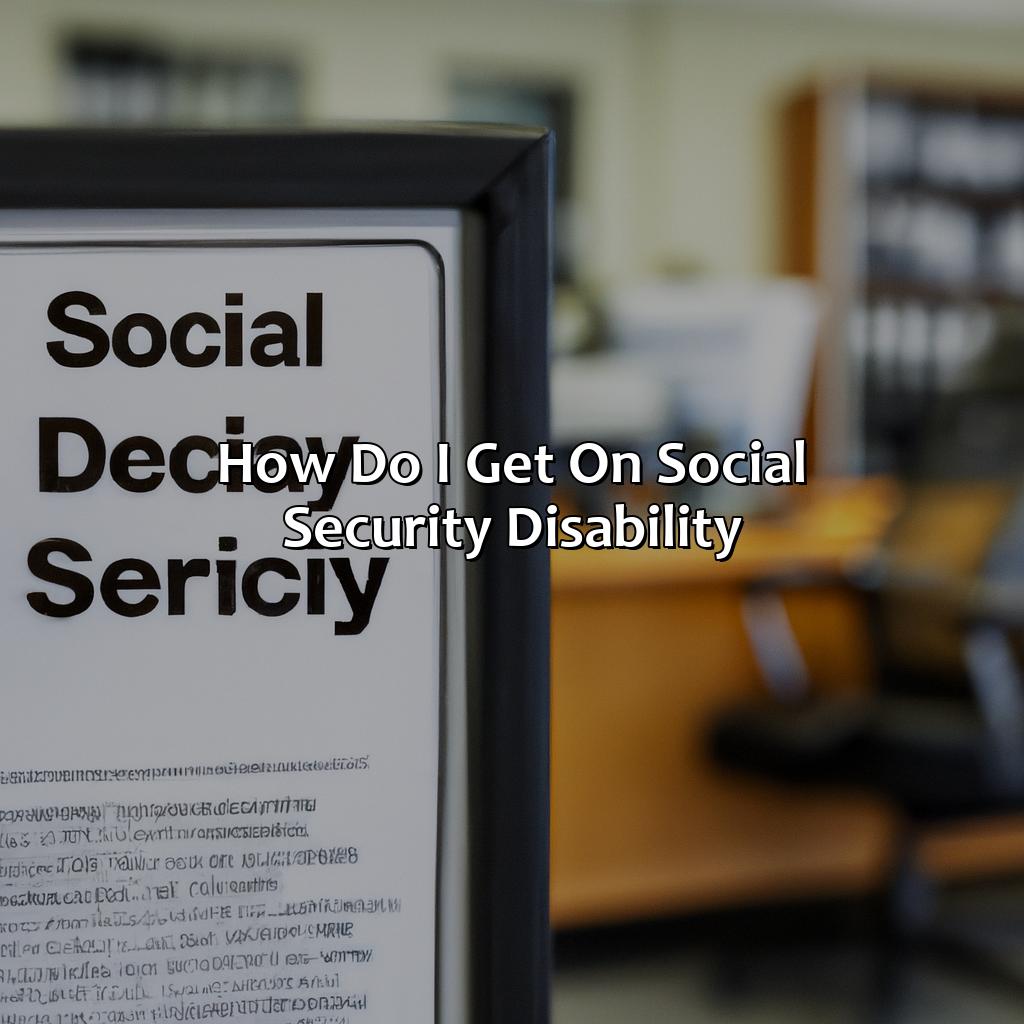How Do I Get On Social Security Disability?
Key Takeaway:
- Eligibility for social security disability benefits requires meeting both medical and non-medical qualifications, including having a condition that prevents one from working and having enough work credits.
- The application process for social security disability benefits requires gathering detailed information and choosing between different types of benefits, with the option to apply online or via paper application.
- If an initial application is denied, the appeal process includes several stages, including reconsideration, a hearing with an Administrative Law Judge, Appeals Council Review, and Federal Court Review.
- Benefits and Supplemental Security Income (SSI) amounts are based on several factors, including the amount of work credits and income earned, and may be taxable.
- Re-evaluation of disability status may occur through continuing disability reviews or medical improvement expected reviews.
Are you worried about how to apply for Social Security Disability benefits? You’ve come to the right place. In this blog, we’ll teach you everything you need to know to get started with the SSD application process.
Eligibility Criteria
Gauging if you qualify for Social Security Disability is essential. The criteria needed to be eligible for it consists of both medical and non-medical components. The medical part concentrates on your disability or condition. The non-medical part takes into account your job experience and financial condition.
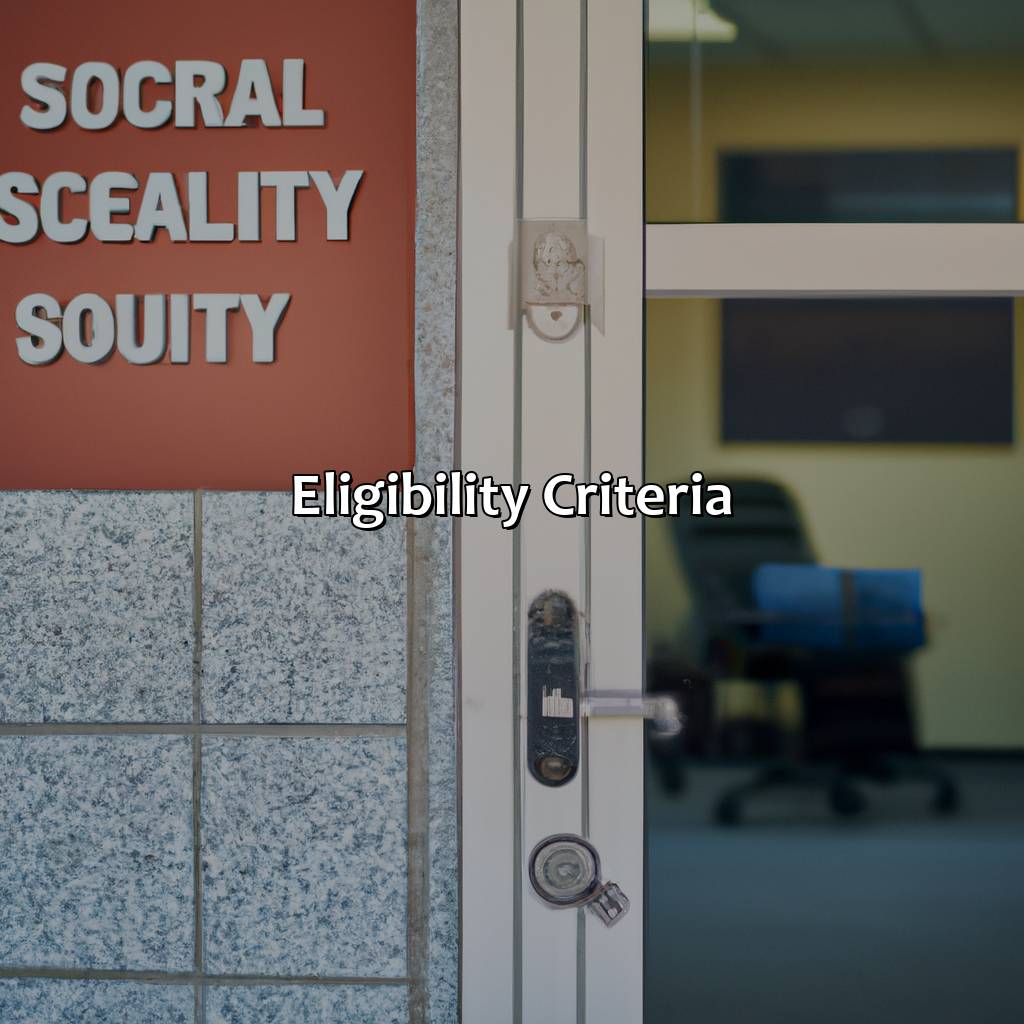
Image credits: retiregenz.com by Joel Duncun
Medical Qualifications
Individuals interested in applying for Social Security Disability benefits must meet specific medical requirements. These requirements stipulate that individuals must have a physical or mental medical condition(s) severe enough to prevent them from being able to work for at least 12 months or result in death. Additionally, applicants’ conditions must be evaluated using the Social Security Administration’s (SSA) Listing of Impairments to determine if they meet a qualifying level of severity.
To be eligible for disability benefits, applicants’ conditions need to match or exceed those outlined in the SSA’s Listing of Impairments. The Listings describe various medical conditions and their associated symptoms that are severe enough to qualify for disability benefits. If applicants’ conditions do not precisely match the Listings, the SSA will evaluate whether their abilities to perform work-related activities have been significantly affected by their medical condition(s).
It is essential to understand that meeting the medical qualifications alone does not guarantee eligibility for disability benefits. Eligibility criteria also consider other requirements, such as an applicant’s work history and income status.
According to the SSA, approximately one in four adult Americans has some sort of disability. (Source: https://www.ssa.gov/disabilityfacts/facts.html)
Apparently, having a PhD in binge-watching Netflix doesn’t qualify you for social security disability.
Non-Medical Qualifications
When applying for social security disability, non-medical qualifications are equally important. A successful SSDI applicant must adhere to strict eligibility criteria set by the SSA. These include having earned enough work credits and meeting income limits. Additionally, a person must be unable to earn more than $1,310 per month due to their disability.
Moreover, educational qualifications and employment history are also considered in the approval process. The Social Security Administration may require proof of previous jobs or mandatory licenses or certificates necessary for specific jobs. Furthermore, an individual with a criminal record may not qualify for SSD benefits.
It is vital to remember that applicants meet all the eligibility criteria before applying as any lapse may negatively impact their case. Avoiding critical information or missing deadlines can delay or even disqualify an application. Ensure thoroughness in validating your details when meeting restrictions.
It is understandable to feel overwhelmed when navigating through Social Security Disability requirements. But failing to act timely may lead to rejection. Therefore, consult with an attorney who specializes in Social Security law while keeping track of any essential information related to your case and seek assistance right away if you encounter challenges.
Applying for social security disability is like trying to navigate a maze, blindfolded, and with only one hand.
Application Process
Want to apply for disability benefits through Social Security? To make sure you get it right, let’s discuss the types of disability benefits available and the information needed. Plus, learn the pros and cons of applying online or using a paper application.
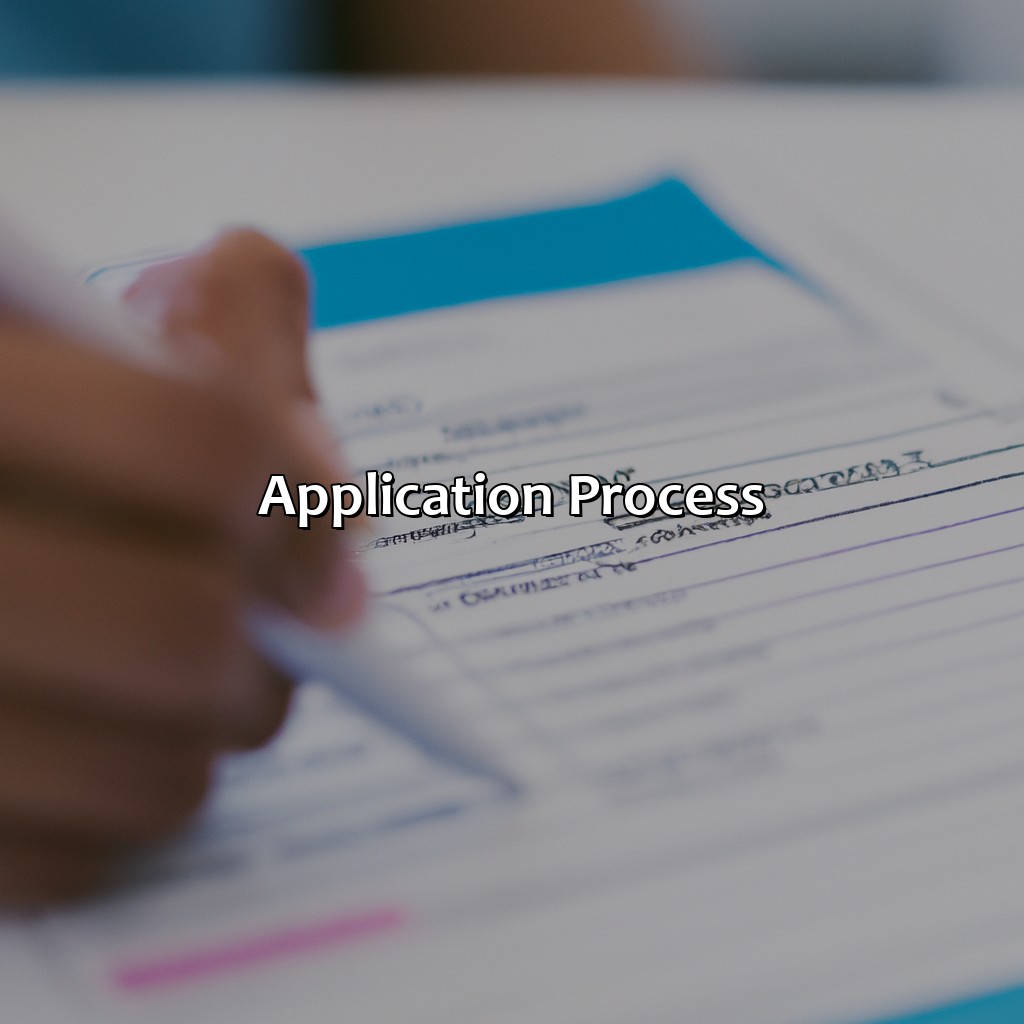
Image credits: retiregenz.com by Adam Woodhock
Information Required
To successfully apply for social security disability, a range of information is required. This can include medical files detailing the extent of the disability, employment history and any relevant financial information, as well as identification documents such as birth certificates and social security cards.
It’s important to gather all necessary documentation ahead of time to speed up the application process. Applicants will also need to provide proof that they are unable to work in their current condition, and may require a doctor’s certificate to support their claim.
In addition to the above documentation, it’s worthwhile preparing a detailed summary of how the disability has impacted daily life. This should cover activities previously enjoyed but no longer possible due to limitations caused by the condition.
One individual who successfully applied for social security disability had been living with chronic back pain which had led to reduced mobility and ability to complete everyday tasks. The applicant provided detailed medical records and a doctor’s certificate demonstrating an inability to work full time due to ongoing health issues. Gradually completing tasks over a longer period helped them secure support from Social Security.
Who said disability can’t have benefits? Let’s explore the silver lining of not being able to work.
Types of Disability Benefits
There are various forms of financial assistance available to those living with disabilities. These provide aid in different areas, keeping in mind the varying needs of individuals. The options for disability benefits include support from government agencies, social security programs, and private organizations. Listed below are the different types of disability benefits that one can explore:
- Supplemental Security Income (SSI)
- Social Security Disability Insurance (SSDI)
- Veterans Administration (VA) Benefits
- Worker’s Compensation Benefits
- Private Disability Insurance
- State Assistance Programs
It is essential to understand that each option comes with specific eligibility criteria which involve detailed application procedures.
When applying for disability benefits, remember that supplementary documents such as medical records and other essential paperwork should be well-prepared. These documents impact the decision-making process and determine the outcome.
To increase your chances of being granted disability benefits, it may be helpful to consult with legal professionals or advocacy groups who specialize in this area. They can help with navigating the application process a bit easier and accurately represent your interests.
Online applications save trees, but paper applications give you something to crumple up and throw at the wall when you get frustrated.
Online vs Paper Application
When it comes to submitting your application for social security disability benefits, you have two options: electronic or paper. Here are the differences:
- Electronic applications can be completed and submitted entirely online. They often include helpful prompts and reminders, as well as immediate confirmation of receipt.
- Paper applications must be printed and filled out by hand or typewriter. They then must be mailed or delivered in person to your local Social Security office.
- Electronic applications may be more efficient because they can be saved, edited, and submitted from anywhere with an internet connection.
- Paper applications may provide a sense of security because you have a physical copy that you can track in the mail or personally deliver.
- Some people prefer electronic applications because they don’t have to leave their homes to complete them, which is especially helpful for those with mobility issues.
- Others may prefer paper applications because they don’t have access to reliable internet, computer, or printer.
It’s important to note that both options require detailed information about your medical condition(s), work history, and other personal information. Ensure all of this is accurate before submitting your application.
One crucial part of the application process is providing the proper documentation to support your claim, such as medical records and a copy of your birth certificate. Make sure you gather all necessary materials before applying.
According to Forbes magazine, “Around 65% of initial disability claims are denied,” so be prepared to appeal if necessary.
Remember that whichever method you choose – online or paper – both require accurate information and proper documentation for review by the Social Security Administration. I hope you have patience and a good lawyer, because the appeal process for social security disability is about as straightforward as a corn maze after dark.
Appeal Process
Four ways exist to take your Social Security Disability claim through the Appeal Process. These are:
- Reconsideration
- Hearing with an Administrative Law Judge
- Appeals Council Review
- Federal Court Review
Each offers different steps and possibilities to appeal your case.

Image credits: retiregenz.com by Adam Woodhock
Reconsideration
Following the initial application process for Social Security Disability benefits, you may receive a determination that denies your claim. To contest this decision, you can initiate a process known as Reconsideration. This process entails asking the Social Security Administration (SSA) to review your case once more.
During Reconsideration, a different SSA representative than the one who initially reviewed your claim will evaluate your file and make a new decision. As part of this process, you may provide additional evidence or documentation to support your case.
If you still receive a denial letter after Reconsideration, you can further appeal through an Administrative Law Judge (ALJ) hearing. This is often considered the most important step in the appeals process, as it gives you the opportunity to argue your case in front of a neutral third party.
In addition to providing medical records and other documentation, it can also be helpful to work with an experienced disability advocate or attorney who can guide you through these processes and ensure that you are presenting your strongest possible case.
One individual who went through this appeals process stated that they were initially denied benefits but ultimately received approval after working with an advocate and presenting their medical history in detail at their ALJ hearing.
Hope you have your best lawyer jokes ready for this hearing with the judge, because it’s about to get legal up in here.
Hearing with an Administrative Law Judge
When filing for Social Security Disability, a hearing with an Administrative Law Judge may be necessary. During this legal proceeding, the judge will question both the applicant and any witnesses to determine if the individual meets the requirements for disability benefits.
It is important to prepare for the hearing by gathering all necessary medical records and documentation of impairment. The judge’s decision will be based on the evidence presented at the hearing, so it is crucial to provide clear and concise information.
In some cases, a vocational expert may also be present to testify about job availability and limitations for those with disabilities. After considering all evidence, the judge will make a decision and provide a written notice of their ruling.
If you do not attend your scheduled hearing without proper cause or notice, you risk losing your chance at receiving Social Security Disability benefits. It is essential to communicate any changes in circumstances or scheduling conflicts with the Social Security Administration promptly to avoid missing out on this vital opportunity.
If getting on social security disability was a video game, the Appeals Council Review would be the final boss battle.
Appeals Council Review
When your initial claim for Social Security Disability benefits is denied, there is hope for you yet. An alternative step is to make a Request for Appeal with the Office of Disability Adjudication and Review, where a judge will review your case and decide whether or not to approve your disability claim. If the judge determines that you are still ineligible, the next option is an Appeals Council Petition.
An Appeals Council Petition serves as your final hope to receive social security disability benefits; however, it can be difficult to accomplish. This request involves several layers of red tape and documentation that must be completed correctly within a specific time frame. Your attorney may assist in drafting skilled briefs and arguments so that your case receives its best possible chance of success.
It’s worth noting that fewer than one-quarter of all cases reviewed by the Appeals Council result in favorable decisions for claimants. However, if you do not pursue this option thoroughly, you risk missing out on compensation that could drastically improve your quality of life.
I hope you have a good lawyer because the only thing more elusive than social security disability benefits is a unicorn at the Federal Court Review.
Federal Court Review
The process for a Social Security Disability appeal is hierarchical. The first level is the reconsideration, followed by a hearing with an administrative law judge, and then an Appeals Council review. If the claimant is still unsatisfied with the decision, they may seek a Federal Court Review.
To seek a Federal Court Review, the claimant must file a civil action in U.S. District Court within 60 days of receiving an unfavorable decision from the Appeals Council. In Federal Court Review, a judge reviews the case and determines whether or not the Administrative Law Judge’s decision was correct under regulations and law.
It is important to note that not all Social Security Disability cases can be appealed to federal court. Only cases where benefits exceed $1,500 per month may be appealed to Federal Court. Additionally, it should be noted that going through Federal Court Review can be a lengthy and complex process.
In one case, a woman who had been diagnosed with multiple sclerosis was denied Social Security Disability benefits multiple times before finally receiving approval after successfully appealing to Federal Court. She hired an attorney who specialized in Social Security Disability appeals and together they were able to present their case effectively in court.
Having trouble making ends meet? Just take comfort in the fact that the government’s idea of ‘supplemental income’ is only a few hundred dollars a month.
Benefits and Supplemental Security Income (SSI)
Want to grasp the advantages of Supplemental Security Income (SSI)? Read on! Here, you will learn all about Benefits and SSI. Plus, you will discover Qualifying Amounts, Taxability, and Factors Affecting Benefits. Get enlightened now!
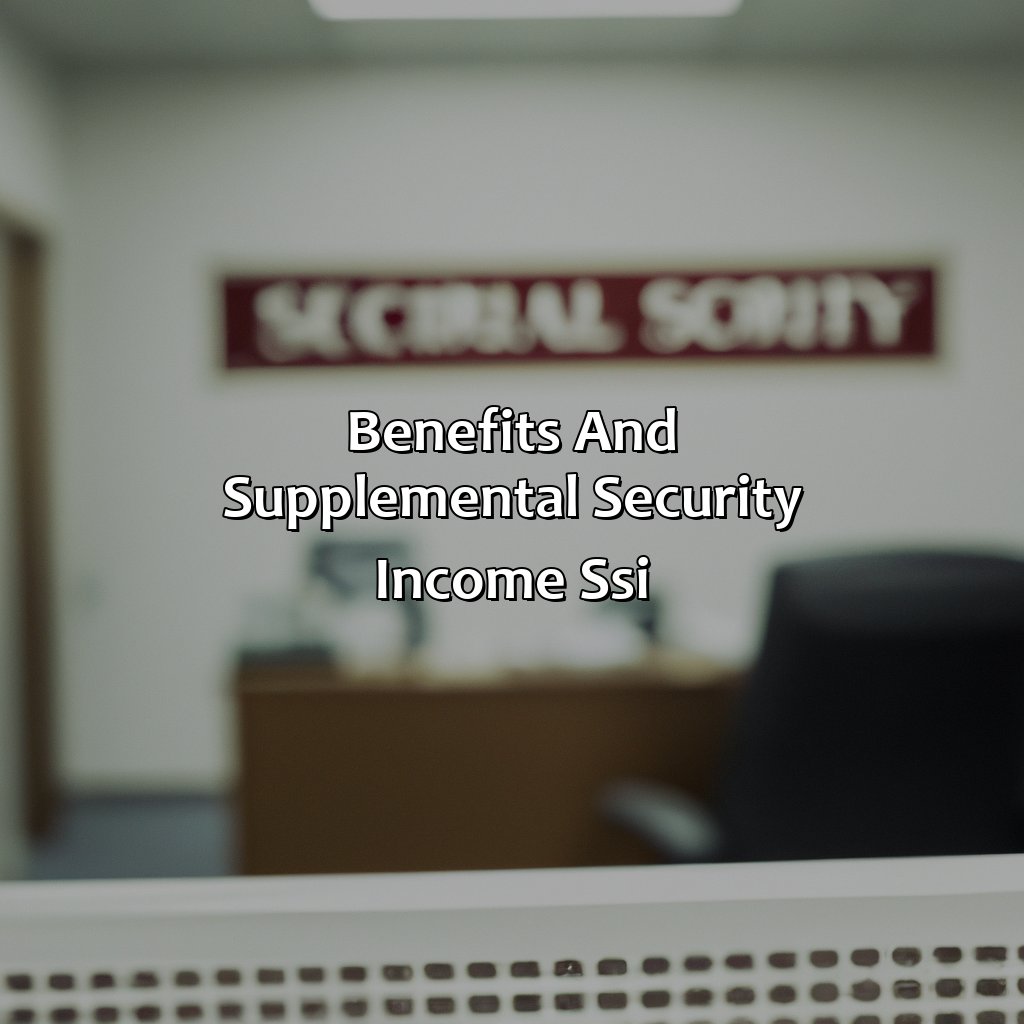
Image credits: retiregenz.com by Joel Woodhock
Qualifying Amounts
The minimum monetary support provided by the government to those eligible for disability benefits is commonly referred to as the ‘Qualifying Amounts.’ To qualify, one must meet certain conditions and earn less than a specific amount of income.
Below is a table outlining the qualifying amounts for various SSI categories based on actual data:
| Category | Monthly Qualifying Amount |
|---|---|
| Individual | $783 |
| Couple | $1,175 |
| Aged | $800 |
| Blind | $2,110 |
| Disabled Child | Varies by Parental Income |
It is important to note that eligibility criteria can vary based on each individual’s circumstances and income.
Additionally, claimants may qualify for both Supplemental Security Income (SSI) and Social Security Disability Insurance (SSDI). These programs have different qualification requirements and benefits.
A woman I knew had been supporting her family with two jobs when she became disabled due to an injury at work. She was unsure of how she would provide for her family without her source of income until she learned about SSI and successfully applied for it, alleviating some of her financial stress.
Uncle Sam giveth with one hand and taketh away with the other, as Supplemental Security Income can be taxed like a bitter pill to swallow.
Taxability
For SSI beneficiaries, taxability depends on their total income or their living arrangements. If they live alone and have no other source of income, they will not owe any taxes on their SSI payments. However, if they receive additional income from work or other sources, portions of their SSI payments may become taxable. On the other hand, if they share a household with someone else as part of a marriage or familial relationship, a portion of their payments may also become taxable. Understanding the taxability rules can help SSI recipients plan effectively and avoid penalties.
It is important to note that not all states follow federal tax laws for SSI benefits and some might waive state income taxes altogether. It is best for SSI beneficiaries to consult with a qualified tax professional to determine whether these benefits are taxable in their state and how much they might owe.
One unique aspect of taxability rules is that certain forms of earned income may lower the tax liability for those receiving SSI payments. Earned income exclusion rules allow an individual to reduce their overall taxable income by up to $9,600 annually based on wages from work or self-employment activities.
According to IRS Publication 915, individuals who received Social Security benefits during the year will receive an SSA-1099 in January showing the total amount of their benefit payment for that year.
Getting social security disability benefits is like playing a game of chance, except the odds are never in your favor.
Factors Affecting Benefits
Certain Factors that Determine Benefits for Supplemental Security Income (SSI) Applicants
The eligibility criteria of Supplemental Security Income or SSI includes several factors that may influence the benefits received by an applicant. These factors are referred to as determinants of benefits and include income, resources, living arrangements, age, and disability.
The following table illustrates how these determinants affect the monthly benefits received by SSI beneficiaries:
| Determinant | Effect on Monthly Benefit |
|---|---|
| Income | Reduces benefit amount dollar-for-dollar above a specified threshold. |
| Resources | Affects eligibility for SSI; asset limit set at $2,000 for individuals and $3,000 for couples. |
| Living Arrangements | Type of residence can impact benefit amount; living alone usually qualifies for more assistance. |
| Age | No direct effect on the amount of benefit; but children may receive different payments than adults. |
| Disability Status | Differently abled individuals may qualify for additional payments besides the baseline SSI amount. The medical severity of the disability is also taken into account while calculating the exact payment. |
In addition to what has been mentioned in Paragraph two above, some States provide supplements to federal payments to help people receiving SSI.
A senior citizen having problems with mobility never applied to SSI. She was unaware of her eligibility criteria until she saw how the Supplemental Security Income had helped her friend. After receiving professional support, she was given monthly assistance that enabled her to gain a sense of financial security and freedom from stress.
Hope you didn’t get too attached to that disability status, because the SSA loves a good re-evaluation.
Re-evaluation of Disability Status
Ensure your disability status is correct and recent. This section on re-evaluation has helpful sub-sections. For example, “Continuing Disability Review” and “Medical Improvement Expected Review“. These will help determine if the disability still meets Social Security’s standards for eligibility and if any changes are needed.
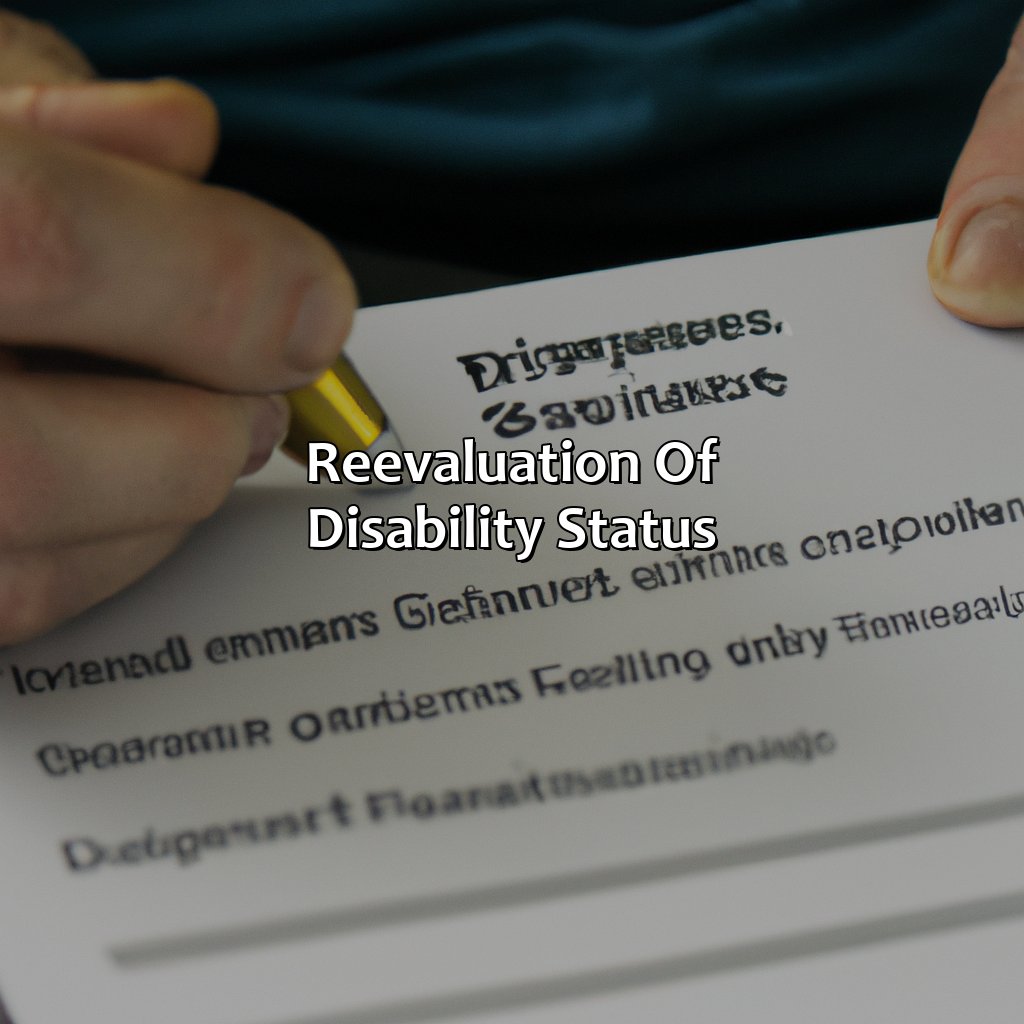
Image credits: retiregenz.com by Adam Washington
Continuing Disability Review
The Social Security Administration conducts periodic evaluations to ensure that individuals who are receiving disability benefits still meet the definition of disabled under the law. These evaluations are known as CDR- Continuing Disability Reviews. The objective of these reviews is to determine whether the individual’s condition has improved, worsened or remained stable over time.
The frequency of CDR depends on the severity and likelihood of improvement in a person’s medical condition. For example, if someone has a severe and chronic condition, they may undergo a CDR every seven years whereas someone with a potentially recoverable illness may have their case reviewed every six months.
To initiate a CDR, SSA mails out review notices to notify beneficiaries that their case is being evaluated for continued eligibility. Once notified, the individual must provide current medical information so that the SSA can evaluate if there has been any improvement in the person’s medical condition and functioning levels.
Failing to provide updated records can result in discontinuation of benefits as well as overpayments which need to be repaid back to the SSA. If an individual disagrees with SSAs decision then they have 60 days from when they receive notice to request reconsideration or appeal of their case through FDDS (Federal Disability Determination Services).
It is essential for beneficiaries receiving SSAs disability benefits to keep up-to-date with their medical providers’ records so that they are not subjected to unexpected consequences such as benefit termination.
You know it’s bad when the government expects improvement from your medical condition, but even your doctor is surprised when you can tie your own shoes.
Medical Improvement Expected Review
If you are receiving Social Security Disability benefits, your medical condition will be subjected to a review by the Social Security Administration (SSA) to evaluate if there has been any improvement in your condition. This is called a Continuing Disability Review (CDR). The purpose of this review is to determine whether there has been any significant improvement in your medical condition that would allow you to return to work.
During the Medical Improvement Expected (MIE) Review, the SSA will re-evaluate your disability status and assess whether or not you are still eligible for benefits. This process involves a thorough assessment of your medical records and any new information regarding your medical condition. If the SSA determines that there has been significant improvement in your condition, they may terminate your benefits.
It is important to note that if you are no longer considered disabled by the SSA, but you believe that you are still unable to work, it is possible to appeal their decision and provide evidence of why you are still disabled.
Don’t risk losing your benefits because of lack of knowledge about the review process. Be sure to keep up-to-date with all communications from the Social Security Administration and be proactive in providing any necessary documentation or information about changes in your medical condition. Your livelihood may depend on it.
Five Facts About Getting on Social Security Disability:
- ✅ Social Security Disability is a program designed to provide financial assistance to individuals with disabilities who are unable to work. (Source: SSA.gov)
- ✅ To qualify for Social Security Disability, you must have a medical condition that meets the SSA’s definition of disability and have paid Social Security taxes while working in the past. (Source: SSA.gov)
- ✅ The application process for Social Security Disability can be lengthy and often requires medical documentation. (Source: The Balance)
- ✅ Social Security Disability benefits are based on your work history and the amount of Social Security taxes you have paid. (Source: SSA.gov)
- ✅ If your initial application for Social Security Disability is denied, you can appeal the decision and have a hearing with an administrative law judge. (Source: Nolo)
FAQs about How Do I Get On Social Security Disability?
How do I get on Social Security disability?
To get on Social Security disability, you must first apply. You can apply online, in person, or over the phone. You will need to provide documentation of your medical condition, work history, and income. Once your application is received, it will be reviewed to determine if you meet the eligibility requirements for disability benefits.
What are the eligibility requirements for Social Security disability?
To be eligible for Social Security disability, you must have a medical condition that is expected to last at least 12 months or result in death, and that prevents you from performing substantial gainful activity. You must also have worked long enough and recently enough to be insured for disability benefits.
What documentation do I need to provide for my Social Security disability application?
You will need to provide documentation of your medical condition, work history, and income. This may include medical records, doctor’s statements, pay stubs, tax records, and other documentation of your work history and income.
How long does it take to get approved for Social Security disability?
The length of time it takes to get approved for Social Security disability varies depending on several factors, including the complexity of your case and the backlog of applications at your local Social Security office. On average, it takes about three to five months to receive a decision on your initial application.
What happens if my Social Security disability application is denied?
If your Social Security disability application is denied, you have the right to appeal the decision. You can request a reconsideration of your case by a different disability examiner, and if that is denied, you can request a hearing before a judge. It is important to enlist the help of an experienced disability attorney at this point to improve your chances of success.
How much will I receive in Social Security disability benefits?
The amount of Social Security disability benefits you receive depends on your work history and earnings. The average monthly benefit for disabled workers in 2021 is $1,277, but the maximum monthly benefit is $3,148. Your exact benefit amount will be determined by a formula that takes into account your lifetime average earnings and other factors.
